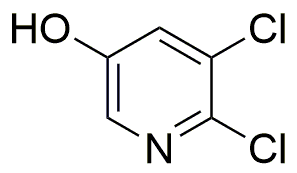2,3-Dichloro-5-hydroxypyridine is widely utilized in research focused on:
- Agricultural Chemicals: This compound serves as an important intermediate in the synthesis of herbicides and fungicides, helping to enhance crop protection and yield.
- Pharmaceutical Development: It is used in the development of various pharmaceuticals, particularly in creating compounds that target specific biological pathways, which can lead to new treatments for diseases.
- Material Science: The chemical is employed in the formulation of specialty materials, including coatings and polymers, where its properties can improve durability and resistance to environmental factors.
- Analytical Chemistry: It acts as a reagent in analytical methods for detecting and quantifying other chemical substances, making it valuable in quality control processes.
- Research Applications: In academic and industrial research, it is used to study reaction mechanisms and the behavior of chlorinated compounds, contributing to a better understanding of chemical interactions.
Información general
Propiedades
Seguridad y normativas
Aplicaciones
2,3-Dichloro-5-hydroxypyridine is widely utilized in research focused on:
- Agricultural Chemicals: This compound serves as an important intermediate in the synthesis of herbicides and fungicides, helping to enhance crop protection and yield.
- Pharmaceutical Development: It is used in the development of various pharmaceuticals, particularly in creating compounds that target specific biological pathways, which can lead to new treatments for diseases.
- Material Science: The chemical is employed in the formulation of specialty materials, including coatings and polymers, where its properties can improve durability and resistance to environmental factors.
- Analytical Chemistry: It acts as a reagent in analytical methods for detecting and quantifying other chemical substances, making it valuable in quality control processes.
- Research Applications: In academic and industrial research, it is used to study reaction mechanisms and the behavior of chlorinated compounds, contributing to a better understanding of chemical interactions.
Documentos
Hojas de datos de seguridad (HDS)
La SDS proporciona información de seguridad completa sobre la manipulación, el almacenamiento y la eliminación del producto.
Especificación del producto (PS)
La PS proporciona un desglose completo de las propiedades del producto, incluida la composición química, el estado físico, la pureza y los requisitos de almacenamiento. También detalla los rangos de calidad aceptables y las aplicaciones previstas del producto.
Certificados de análisis (COA)
Busque certificados de análisis (COA) ingresando el número de lote del producto. Los números de lote y de partida se pueden encontrar en la etiqueta de un producto después de las palabras "Lote" o "Lote".
Número de catálogo
Número de lote/lote
Certificados de origen (COO)
Este certificado de origen confirma el país en el que se fabricó el producto y también detalla los materiales y componentes utilizados en él y si se deriva de fuentes naturales, sintéticas u otras fuentes específicas. Este certificado puede ser necesario para cumplir con las normativas aduaneras, comerciales y regulatorias.
Número de catálogo
Número de lote/lote
Hojas de datos de seguridad (HDS)
La SDS proporciona información de seguridad completa sobre la manipulación, el almacenamiento y la eliminación del producto.
DownloadEspecificación del producto (PS)
La PS proporciona un desglose completo de las propiedades del producto, incluida la composición química, el estado físico, la pureza y los requisitos de almacenamiento. También detalla los rangos de calidad aceptables y las aplicaciones previstas del producto.
DownloadCertificados de análisis (COA)
Busque certificados de análisis (COA) ingresando el número de lote del producto. Los números de lote y de partida se pueden encontrar en la etiqueta de un producto después de las palabras "Lote" o "Lote".
Número de catálogo
Número de lote/lote
Certificados de origen (COO)
Este certificado de origen confirma el país en el que se fabricó el producto y también detalla los materiales y componentes utilizados en él y si se deriva de fuentes naturales, sintéticas u otras fuentes específicas. Este certificado puede ser necesario para cumplir con las normativas aduaneras, comerciales y regulatorias.


